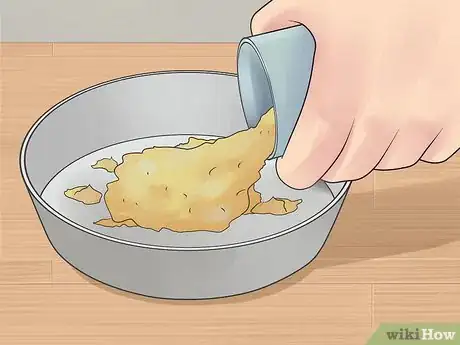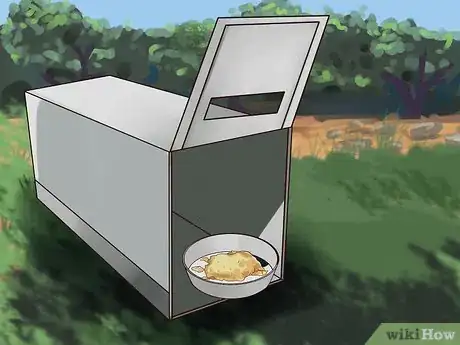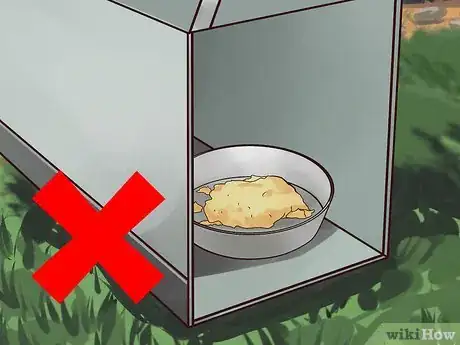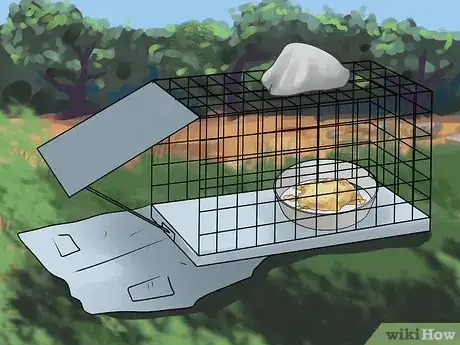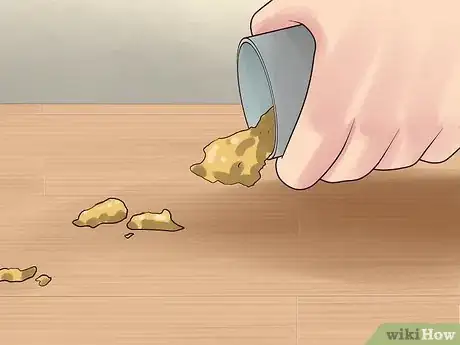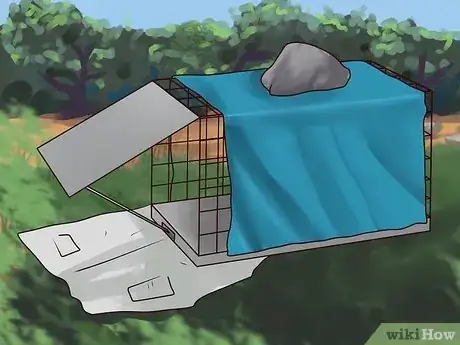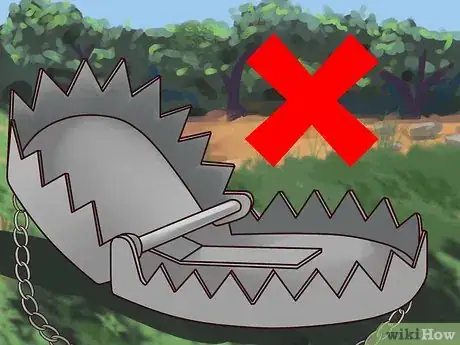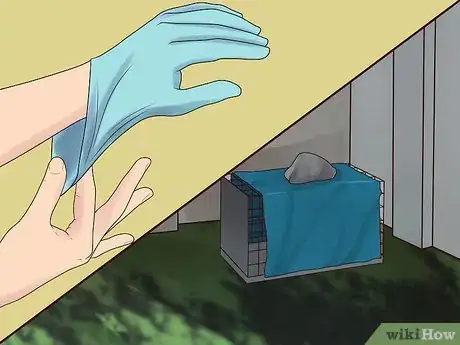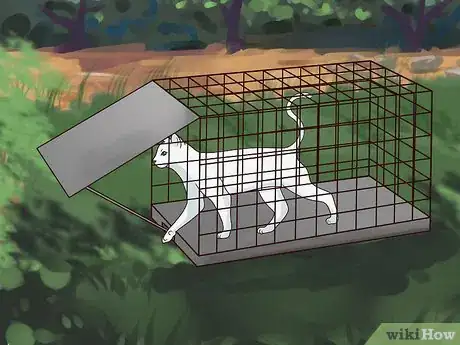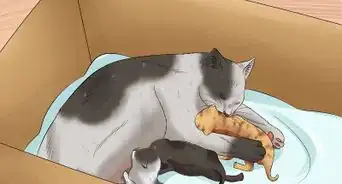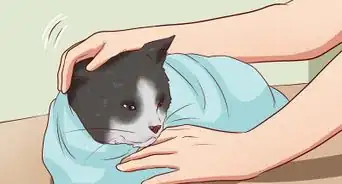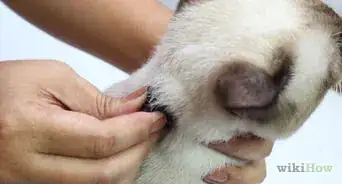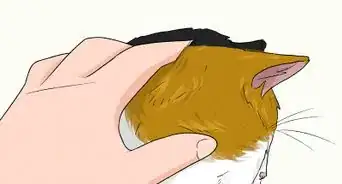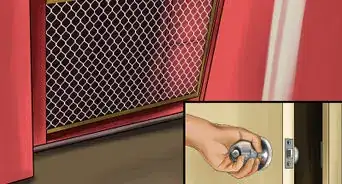wikiHow is a “wiki,” similar to Wikipedia, which means that many of our articles are co-written by multiple authors. To create this article, 16 people, some anonymous, worked to edit and improve it over time.
This article has been viewed 68,960 times.
Learn more...
Since pet cats are usually so cute, warm, and cuddly, it's all-too-easy to think the same of feral cats in your neighborhood. Unfortunately, left unchecked, feral cats can be harmful to themselves and others. Feral cat populations can multiply quickly, leading to overpopulation, competition among cats for food and living space, and nuisances like loud cat calls, foul-smelling urination from male cats, and more.[1] To fight the problems caused by feral cat populations, most animal societies recommend trapping cats and taking them to a veterinarian for spaying or neutering.
Steps
Preparing to Trap a Cat
-
1Ask your neighbors not to leave food out. Trapping feral cats is a community effort. You have the best possible chance of catching cats if you can get them to develop a routine of coming to your house (and no one else's) for food. This way, by the time you decide to start trapping cats, they'll feel safe around your house and won't suspect your trap. Ask your neighbors to cooperate by not leaving food out for the feral cats — you don't want the cats to be at a neighbor's house when your trap is out.
- You may also want to alert your veterinarian that you intend to trap a feral cat (or cats) and will bring them in for treatment. However, since you don't know exactly which night you'll be catching a cat, don't commit to a firm date.
-
2Start leaving food out each evening. Leave a dish of food in an easy-to-access spot each evening. Remove the dish and clean it every morning, then repeat the following night. To encourage the cats to develop a habit of coming to your house for food, put the food out at the same time, in the same place every night.
- In terms of food, you ideally want something both that tastes good to the cats and has a strong scent. Canned fish work well — tuna, mackerel, or sardines in oil are all good choices. Chicken, liver, and other meats also work, as does canned cat food.
Advertisement -
3Set an unset open trap near the feeding area for several days. Cats generally aren't stupid animals — they'll be wary if their food suddenly appears one night in the middle of a metal cage. To get the animal accustomed to seeing and smelling the trap, leave it out for several nights right next to the food. You can even eventually put the food inside a trap that is tied open.
- Be patient — taking the time to get a cat used to this trap now will make it much easier to trap the cat in the long run.
- You will want to use a standard, box-style live trap for this task. See the section below for more information on which types of traps are (and aren't) appropriate.
-
4If possible, monitor the cats as they feed one or more nights. If you get the chance, try waiting about 20 feet away the trap one night (or, if possible, behind a nearby window.) Take notes on the cats as they arrive and begin to feed — assign each one a name or number so that you can keep track of them. Look for signs that might tell you whether each cat is a feral or a stray (i.e., a cat that was raised outside versus one that at one point had a home.) Identifying signs of a stray cat will help the animal agency that it winds up at find it a new home.
-
Stray cats (cats that used to have a home) generally:[2]
- Feel more comfortable approaching humans
- Are more likely to be by themselves
- Are more likely to have a friendly, open appearance (tail up, eye contact, etc.)
- May make more noise
-
Feral cats, on the other hand:
- Will usually stay away from humans
- Are more likely to live in packs or colonies
- Are more likely to have a guarded, tense appearance (low, slinking posture, tail down, etc.)
- Are usually silent
- Will often have fairly clean coats
-
Stray cats (cats that used to have a home) generally:[2]
-
5Do not leave food out the night before trapping. Even if your feral cat eventually gets used to feeding at your house, they can still be wary of food left inside a trap. To give the cat extra incentive to go for the bait, skip one day of feeding him. This will leave him extra hungry the following night, which will make him more eager to take risks (like crawling into your trap) to get food.
Trapping a Cat Humanely
-
1If you don't have one, buy a live trap. The sort of trap you should generally use for cats is the same sort that's often used for skunks, raccoons, and other small pests. The trap should look like a long rectangular wire cage with a slanted trap door at one end. The door swings shut when the cat steps on a pad at the rear of the trap while trying to eat food. These traps are commonly sold at hardware and hunting goods stores — make sure you buy one that's big enough to fit a fully-grown cat.
- Depending on their size, live traps can retail for anything from $20 to about $100. Generally, for a reliable trap, this money is worth it. Don't try to save money by improvising your own trap unless you're an experienced trapper — there's a risk the cat may escape or be injured.
-
2Set your baited trap out in a flat, secure area. The evening after you skip feeding your cat, put your trap out with a little food on a small dish or paper towel behind the pressure plate. Ideally, the site of the trap should be perfectly flat so that the trap doesn't shake or rattle when the cat walks into it and scare the animal away.
- You may also want to put something heavy (like a rock) on top of the trap so that it is weighed down and won't move when the cat enters.
- Though it's not required, you may also want to place a piece of newspaper or a towel on the floor at the front of the trap to make the cold metal floor of the trap more inviting. This will also prevent the cat's feet from slipping through the bars when you pick the trap up. You will want to put a very small amount of food at the front of the trap as a teaser. Cover the trap with a towel or sheet so the cat feels confined and safe after being trapped.
- Some people like to put a flattened cardboard box underneath the trap for easy clean-up. This isn't essential, but it can keep food bits from the bait trail from working their way into the ground.
-
3Optionally, cover the trap. Trappers are somewhat divided on the issue of whether or not it's a wise idea to cover the trap with a towel before leaving it out. Those in favor believe that the towel helps to camouflage the trap and comfort the animal once it's caught.[3] On the other hand, those against it believe that being able to see through the trap makes it seem like less of a threat to the cat. Whether or not you cover your trap is up to you — if you follow the rest of the steps, it's not likely to make a major difference either way.
- If you do cover the trap, ensure that the towel you use doesn't interfere with the mechanism of the trap before you leave it out.
-
4Check your trap at least semi-frequently. Now, all you need to do is wait. If you want to stay near the trap, make sure you're far enough away that the cat won't be threatened by your presence. Assuming you set your trap out at dusk, you'll want to check your trap at least once before you go to bed. After that, you'll want to check on the trap as soon as you wake up in the morning to see whether your trap has caught anything. Note that some animal societies even recommend keeping constant surveillance on the trap.[4]
- Note also: It is inhumane to leave a cat (or any other animal) in a trap for prolonged periods of time. Inside a trap, an animal has no access to food or water (unless you provide it), no room to stretch out, and no way to move away from its urine or excrement. In addition, in weather that is very hot or cold, staying in a trap for any length of time can be dangerous and may even lead to the animal's death from exposure, so it's extra-important to check the trap as soon as you can.
-
5Don't use inhumane alternative traps. Up to this point, we've only mentioned standard box-style live traps in terms of options for trapping cats. While there may be other effective options available, you will never, ever want to use a trap that has a chance of hurting or maiming the cat. Traps you should definitely avoid include:[5]
- Steel jaw traps (i.e., bear traps)
- Wire or rope snares
- Traps that grip or crush the body
- Any trap that hangs the animal by a limb
Dealing With a Trapped Cat
-
1Assess the cat's condition. As soon as you notice that you've caught a cat, carefully remove any towels you may have laid over the trap and check to see that the cat is healthy. Use caution here — though some cats may be docile, feral cats that are not accustomed to people may become agitated. Look for obvious injuries or signs of malnourishment and contact a vet right away if you find any. Cover the cat again as soon as you can — this will calm it and keep it from thrashing and yowling.
- If you notice that your trapped cat is a lactating female, you will need to take it to the vet and release it as soon as possible. Lactation is a sign that a mother cat has kittens, who can not generally survive on their own for long periods of time.
- If you end up trapping a neighborhood pet or a wild animal, simply release it according to the directions below.
-
2Move the trap to a safe area until you can take the cat to the vet. If you can't immediately take the cat to the vet, put it in a safe but secluded spot away from children and other animals, like a garage or basement. Keep the trap covered while you do so to keep the cat calm. Most importantly, wear hand protection (especially if you're dealing with a feral cat) to protect yourself both from scratches and microorganisms that may be present on the cat.
- You may also want to elevate the trap on pieces of wood or bricks so that waste will fall through the wire. Place newspaper under the elevated trap.
- If you intend to trap more than one cat you should put 1-2 more traps than cats you expect to trap out when you start the process.
- Avoid feeding the cat. Opening the trap gives the cat an opportunity to lunge for the exit or scratch you. In addition, if the vet ends up recommending surgery (such as spaying or neutering) for the cat, the procedure will be easiest if the cat has an empty stomach.
-
3Take the cat to a vet at the earliest chance. Even if the cat you've trapped appears perfectly healthy, it's important that you take it to the vet as soon as you can. Feral cats can sometimes be carriers of diseases, though the risk of a seemingly healthy cat having an extremely dangerous disease like rabies is very, very small.[6] More likely, however, is that the feral cat will breed if released without seeing a vet. As mentioned above, large feral cat populations can quickly become nuisances to the neighborhood, so it's wisest to have the cat spayed or neutered.
- Note that some vets offer discount rates for spaying or neutering feral cats as a service to the community.[7]
- If the cat is unhealthy or requires serious medical care, be prepared to make a decision with your vet about whether or not to humanely euthanize it. For a feral cat in the wilderness, a major medical condition can mean a slow, painful death.
-
4Release the cat. After the cat has seen the vet, simply take it to the place where you originally caught it and open the trap. Use hand protection as you handle the trap. Allow the cat to leave on its own — don't give it a goodbye petting.
- Do not take the cat to someplace unfamiliar when you release it. The cat will usually become disoriented, get lost, and eventually die if you do this.[8]
- After you release the cat, wash both the trap and your hands with bleach, soap and water.
Community Q&A
-
QuestionCan I make a cardboard trapdoor for trapping kittens?
 Community AnswerYes, but make sure the door can't hurt the kittens in any way. If the cardboard you're using has jagged edges or sharp corners, don't use it.
Community AnswerYes, but make sure the door can't hurt the kittens in any way. If the cardboard you're using has jagged edges or sharp corners, don't use it. -
QuestionIf a cat is released into the wild, or even the city streets, should I take into consideration the birds, rabbits, squirrels etc. they will kill to survive?
 Community AnswerNo. They would be part of the food chain, like any of the other animals you mention.
Community AnswerNo. They would be part of the food chain, like any of the other animals you mention. -
QuestionHow should I trap a kitten and prevent it from running away?
 Community AnswerYou should not trap it, as you can cause severe harm to the kitten.
Community AnswerYou should not trap it, as you can cause severe harm to the kitten.
Warnings
- Change your clothes before having any contact with your own pets to avoid spreading diseases from the feral cats. Wash the clothes separately to avoid cross contamination with your other clothes. If possible, use bleach.⧼thumbs_response⧽
- Some diseases show no symptoms early on. Be sure to isolate all cats and kittens from your own pets and get them checked out by your veterinarian.⧼thumbs_response⧽
Things You'll Need
- Live trap
- Flashlight
- Protective gloves/clothing
- Cat food with cover or covered container
- Spoon
- Newspaper
- Wood or bricks
- Kitten milk (if necessary)
References
- ↑ http://www.humanesociety.org/issues/feral_cats/qa/feral_cat_FAQs.html
- ↑ http://www.alleycat.org/StrayOrFeral
- ↑ http://www.feralcat.com/trapinst.html
- ↑ http://bestfriends.org/Resources/No-Kill-Resources/Cat-initiatives/Helping-Community-Cats/Humane-Trapping-Instructions-for-Community-Cats/
- ↑ http://www.peta.org/issues/wildlife/cruel-wildlife-control/cruel-wildlife-trapping/
- ↑ http://www.alleycat.org/Rabies
- ↑ http://bestfriends.org/Resources/No-Kill-Resources/Cat-initiatives/Helping-Community-Cats/Humane-Trapping-Instructions-for-Community-Cats/
- ↑ http://bestfriends.org/Resources/No-Kill-Resources/Cat-initiatives/Helping-Community-Cats/Humane-Trapping-Instructions-for-Community-Cats/
About This Article
Before trapping a cat for spaying or neutering, get a box-style live trap with a slanted trap door at one end. Next, place the open, unset trap in your yard with a dish of food right next to it. After several days, start placing the food inside the open trap so that the cat gets comfortable with it. Then, set up the trap in a flat, secure area with a small dish of food placed behind the pressure plate. Throughout the day, check on trap as often as you can to ensure that the cat isn’t left inside it for too long. For more advice, including how to make the trap more secure and inviting to the cat, keep reading.

